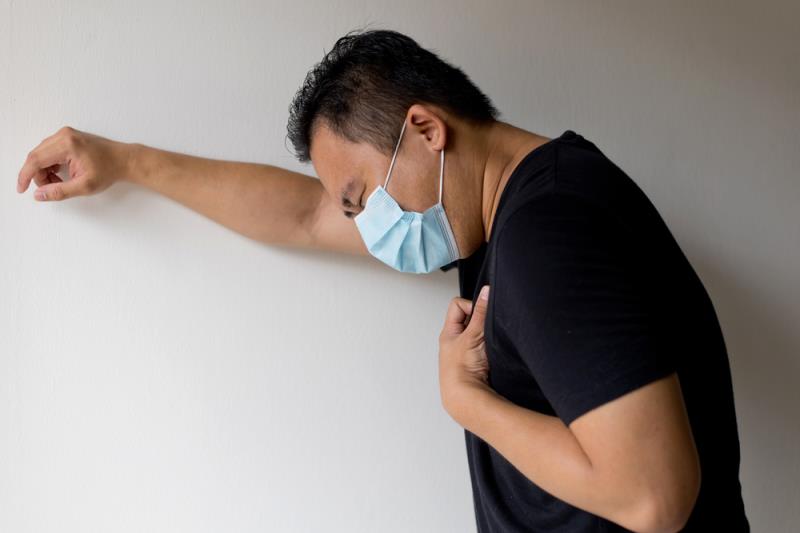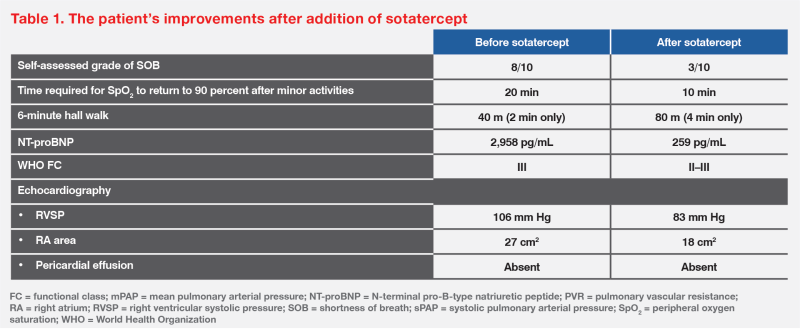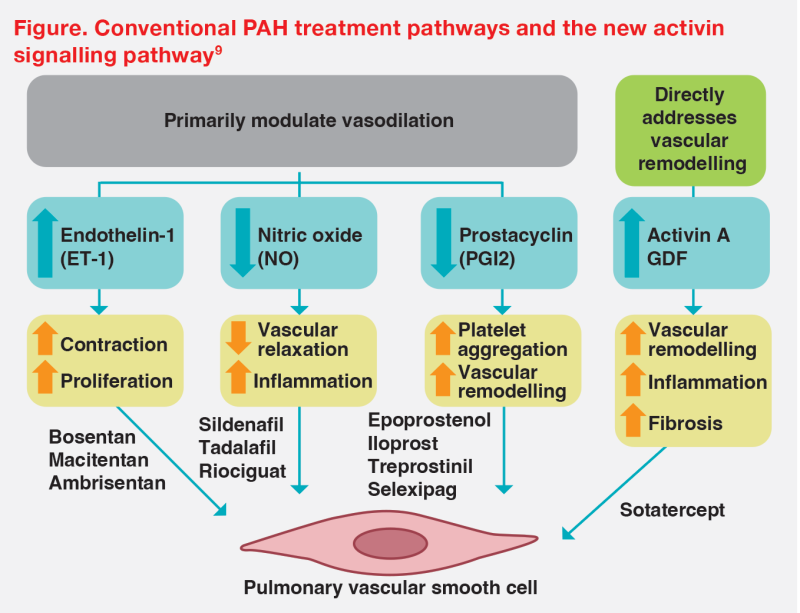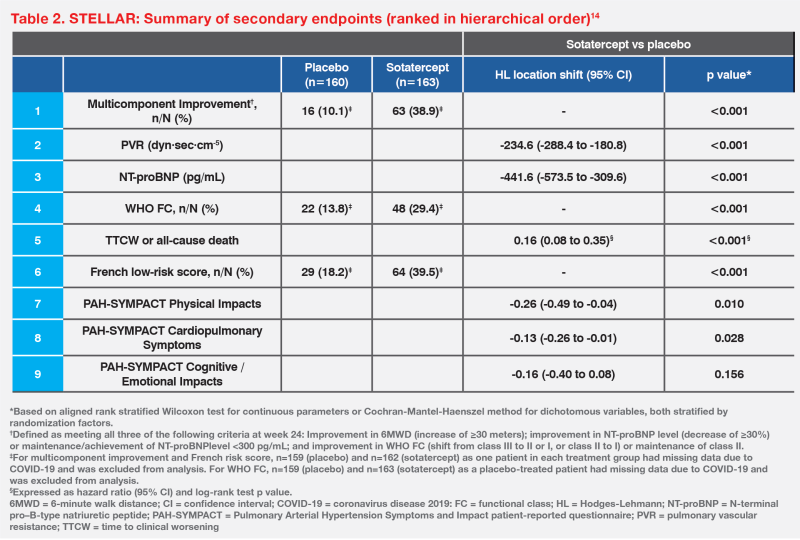First experience with sotatercept for pulmonary arterial hypertension in Southern China













Presentation and investigations
A 77-year-old male chronic smoker with a history of diabetes mellitus, hypertension, coronary artery disease treated with stenting to left circumflex artery and ramus intermediate artery in 2015, chronic obstructive pulmonary disease (COPD), and interstitial lung disease (ILD) presented on 19 January 2024 with shortness of breath (SOB) on exertion, which began following an episode of COVID-19 in May 2023 and worsened after a subsequent COVID-19 episode in April 2024. Before the two COVID-19 episodes, the patient had good exercise tolerance and could manage a 1-hour hike.
At presentation in January 2024, his blood pressure was 138/79 mm Hg with a pulse rate of 101 bpm, and his peripheral oxygen saturation (SpO2) was 85 percent while receiving supplemental oxygen at 3 L/min via a portable O2 concentrator. The patient required an oxygen concentrator for both home use and outings. After minor activities such as bathing, his oxygen saturation would drop to 60 percent, and it would take 20 minutes of rest for his oxygen level to return to 90 percent, placing him in WHO functional class (FC) III. His self-assessed grade of SOB was 8 out of 10, with 10 being the worst. (Table 1)

Initially, the patient was treated for COPD with decompensation following the second episode of COVID-19 infection. However, his symptoms progressively worsened. In late July 2024, electrocardiography (ECG) revealed sinus rhythm wave in V1 and right ventricle (RV) strain with T wave inversion in the right pre-cordial V1–4, suggesting increased right heart pressure. Echocardiography showed indicators of pulmonary hypertension (PH), such as a D-shaped interventricular septum during diastole, enlarged RV and right atrium (RA), and moderate tricuspid regurgitation with elevated RV systolic pressure (RVSP) of 106 mm Hg. His left ventricular ejection fraction was normal at 60 percent. N-terminal pro-B-type natriuretic peptide (NT-proBNP) level was elevated at 2,958 pg/mL. (Table 1)
Full lung function test showed no obstructive or restrictive pattern, but markedly reduced diffusion capacity was present, excluding the possibility of COPD and fibrosis as the cause of dyspnoea. CT pulmonary angiography showed no evidence of pulmonary embolism, with pulmonary arteries well opacified by contrast and no abnormal filling defects indicating thrombus. Chest CT showed extensive emphysematous changes over both lungs, septal thickening intermixed with ill-defined patchy ground glass opacities, and multiple tiny, calcified foci in bilateral lung bases, right middle lobe, and lingular, indicating postinflammatory change of ILD.
Right heart catheterization (RHC) was performed on 3 January 2025, which revealed a mean pulmonary arterial pressure (mPAP) of 34 mm Hg, increased pulmonary vascular resistance (PVR) of 7.94 WU, pulmonary artery wedge pressure (PAWP) of 9 mm Hg, mean right atrium pressure of 8 mm Hg, pulmonary artery oxygen saturation of 58 percent, reduced cardiac output (Fick cardiac output, 2.3 L/min; Fick cardiac index, 1.38L/min/m), and normal left ventricular end-diastolic pressure. PVR and PAP did not improve with 100 percent oxygen therapy, and PVR did not decrease with vasoreactivity testing using adenosine infusion. Intracardiac shunt was excluded as there was no stepping up of oxygen saturation.
The findings led to a diagnosis of idiopathic pulmonary arterial hypertension (PAH) with a high-risk stratification based on the three-strata model.
Treatment and response
Triple therapy consisting of sildenafil 80 mg TID (initiated in July 2024; increased from 20 mg BID to 80 mg TID in December 2024), macitentan 10 mg QD (started in August 2024), and selexipag 1.6 mg BID (initiated in January 2025; increased from 0.2 mg BID to 1.6 mg BID over 2 months) was sequentially started from 31 July 2024. However, there was no significant clinical or echocardiographic response.
During a 6-minute hall walk test in March 2025, the patient had to stop after walking for just 2 minutes (having covered only 40 m) due to SOB, despite receiving supplemental oxygen at 3 L/min, and his SpO2 level dropped to 72 percent. (Table 1)
The first dose of subcutaneous sotatercept 16.2 mg was added to the current treatment on 17 April 2025 and the dosage was uptitrated to 38.64 mg on 8 May 2024 (second dose) and to 38.85 mg on 29 May 2025 (third dose).
After four 3-weekly injections, the patient showed definite signs of clinical improvement, with a self-assessed grade of SOB improving from 8 to 3 out of 10. His SpO2 returned to 90 percent in a shorter time (10 minutes) after bathing. His 6-minute hall walk distance doubled to 80 m in 4 minutes, NT-proBNP level reduced to 259 pg/mL, and WHO FC improved to II–III. (Table 1) Follow-up risk reassessment revealed intermediate-high risk status based on the four-strata model.
The patient tolerated sotatercept well, without experiencing any evident adverse events (AEs). His haemoglobin and platelet levels were within normal ranges throughout the treatment. Last seen on 19 June 2025, after 3 months of sotatercept treatment, his RVSP reduced to 83 mm Hg. (Table 1)
Discussion
Many faces of PH
PAH (WHO Group 1 PH) is a rapidly progressive and life-limiting disease characterized by proliferative remodelling of small pulmonary arteries and progressive luminal narrowing, ultimately leading to right heart failure and death.1-4 WHO classifies PH into five groups based on underlying causes:3,4
PAH: Rare and challenging to diagnose
PAH is a rare type of PH that can be idiopathic, hereditary, induced by toxins or drugs, or associated with connective tissue diseases, HIV infection, portal hypertension, congenital heart disease, or schistosomiasis.4 Based on a systematic analysis of the Global Burden of Disease Study 2021, the age-standardized prevalence of PAH was 2.28 cases per 100,000 population, which translates to approximately 170 cases of PAH in Hong Kong.5
On average, it takes 1–4 years from the onset of the first symptoms to confirm the diagnosis of PAH. As seen in our case, patients with PAH generally present with nonspecific symptoms, such as dyspnoea on exertion and fatigue. These symptoms may be attributed to general deconditioning or other comorbid cardiopulmonary conditions, making early diagnosis of PAH challenging.6
Possible clues for correct diagnosis
In our patient with multiple cardiopulmonary comorbidities, the diagnostic process was particularly challenging. However, worsening of symptoms following COVID-19 provided clues, as did comprehensive lung and heart assessments for exclusion of other potential causes of exertional dyspnoea, including lung and cardiac diseases (eg, COPD, ILD, coronary artery disease).3,7
RHC is the gold standard for diagnosing and classifying PH. Based on the updated haemodynamic definition, PAH may be diagnosed in patients with mean PAP >20 mm Hg and PVR >2 WU.3
Conventional therapies help, but are they enough?
The prognosis of PAH is typically poor, with a median overall survival (OS) of 2.8 years in untreated patients.8 Conventional PAH therapies target the endothelin-1 (ET-1), nitric oxide (NO), and prostacyclin (PGI2) pathways, which mainly promote vasodilation.9 (Figure)
When given alone or in combination, these conventional treatments may enhance pulmonary haemodynamics, increase exercise capacity, and prolong progression-free survival in patients with PAH.2 For example, the SERAPHIN and GRIPHON trials showed that macitentan and selexipag significantly lowered risks of morbidity and mortality in PAH patients, with hazard ratios (HRs) of 0.70 (p=0.01) and 0.60 (p<0.001), respectively, vs placebo.10,11
However, overall mortality remains high, with a mean OS of 5–7 years with conventional treatments. No significant improvements in survival were observed during the past decade, and patients often experienced severe disability in the final months of life. This underscores the need for additional treatment options that target new pathways involved in pulmonary vascular remodelling.2,5
Is sotatercept a disease-modifying treatment?
Sotatercept, a first-in-class activin signalling inhibitor, received US FDA approval in March 2024. It works by restoring balance between the antiproliferative and proproliferative signalling pathways. Unlike current vasodilatory therapies, sotatercept holds promise as a disease-modifying treatment because it directly targets the pathophysiological mechanism in PAH.2,9,12 (Figure)

Our patient sequentially received sildenafil, macitentan, and selexipag, targeting all three treatment pathways. However, he was refractory to all conventional treatments. (Figure) In PAH, nonresponders have worse survival than long-term responders.13 At this point, sotatercept was the only remaining hope for the patient, aside from a lung transplant or heart-lung transplant.
STELLAR: Efficacy and safety findings
The decision to add sotatercept to triple therapy was based on the multicentre, double-blind, phase III STELLAR trial in 323 adult patients (median age, 47.9 years; female, 79.3 percent) with PAH (WHO Group 1, FC II [48.6 percent] or III [51.4 percent]) who were receiving stable background therapy, including triple therapy (61.3 percent), prostacyclin infusion therapy (39.9 percent), double therapy (34.7 percent), and monotherapy (4.0 percent). Patients were randomized 1:1 to receive subcutaneous sotatercept (starting dose, 0.3 mg/kg; target dose, 0.7 mg/kg) or placebo Q3W.2
STELLAR met its primary endpoint by demonstrating an improvement from baseline in 6-minute walk distance (6MWD) at week 24. Sotatercept significantly improved 6MWD by 40.8 m vs placebo (p<0.001), indicating enhanced exercise capacity.2 Consistently, our patient’s 6-minute hall walk improved from 40 to 80 m.
In addition, sotatercept demonstrated statistically significant improvements in eight out of nine prespecified secondary endpoints, including multicomponent improvement, PVR, NT-proBNP, WHO FC, time to death or clinical worsening, French low-risk score, as well as changes in PAH–Symptoms and Impact (PAH-SYMPACT) physical impacts and cardiopulmonary symptom domains (p<0.05 for all). The PAH-SYMPACT cognitive/emotional impacts domain, which was assessed as the final secondary outcome measure, did not achieve statistical significance (p=0.156).2,14 (Table 2) The subjective improvements in quality of life and objective improvements in WHO FC and NT-proBNP are similarly observed in the above case.

Of note, treatment with sotatercept resulted in an 84 percent lower risk of a composite of death from any cause or nonfatal clinical worsening event (5.5 vs 26.2 percent; HR, 0.16; 95 percent confidence interval [CI], 0.08–0.35; p<0.001) vs placebo.2 (Table 2)
Sotatercept was associated with lower rates of AEs (84.7 vs 87.5 percent) and serious AEs (14.1 vs 22.5 percent) vs placebo. AEs that occurred more frequently with sotatercept than with placebo included epistaxis (12.3 vs 1.9 percent), dizziness (10.4 vs 1.9 percent), telangiectasia (10.4 vs 3.1 percent), thrombocytopenia (6.1 vs 2.5 percent), increased haemoglobin levels (5.5 vs 0 percent) and increased blood pressure (3.7 vs 0.6 percent).2
Close monitoring for early intervention
Although at a later PAH stage (WHO FC III), our patient, who was refractory to all conventional medications, still responded to sotatercept. However, early intervention is important, as early use of sotatercept may help prevent or delay the onset of irreversible symptoms and clinical worsening events (eg, deterioration requiring lung or heart-lung transplantation) by targeting the underlying mechanisms of PAH.
Severe SARS-CoV-2 infection may cause pulmonary vascular injury, which may aggravate PAH. Given the persistence of COVID-19, clinicians should closely monitor PAH patients, as they may be at increased risk of complications and poorer outcomes following COVID-19.15,16
Conclusion
Due to its rapidly progressive nature, the treatment strategy for PAH has shifted from targeting individual pathways to earlier and more aggressive use of combination therapy.1,9 Considering its potential disease-modifying properties, tolerability, and improvements in 6MWD, haemodynamic parameters and quality of life, as well as the 84 percent reduction in risks of all-cause mortality and nonfatal clinical worsening of PAH, the addition of sotatercept to background therapy should be considered in patients at earlier stages (eg, WHO FC II) to optimize outcomes.